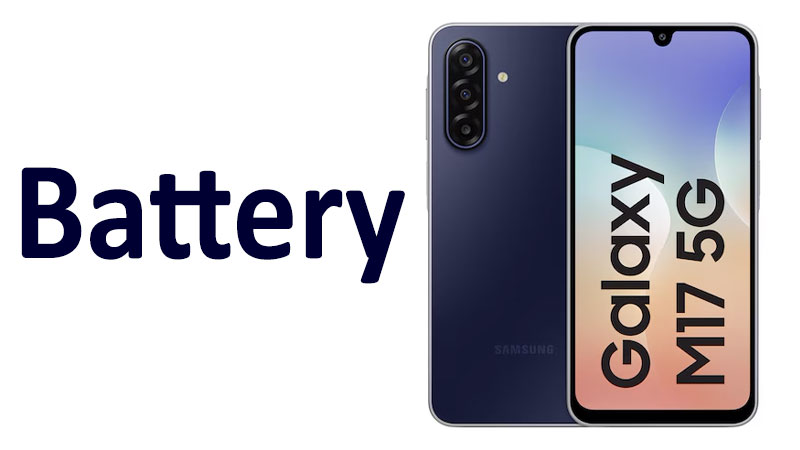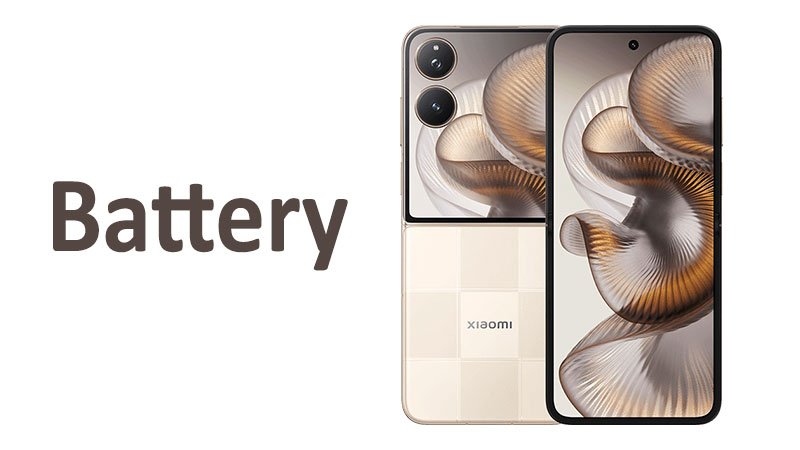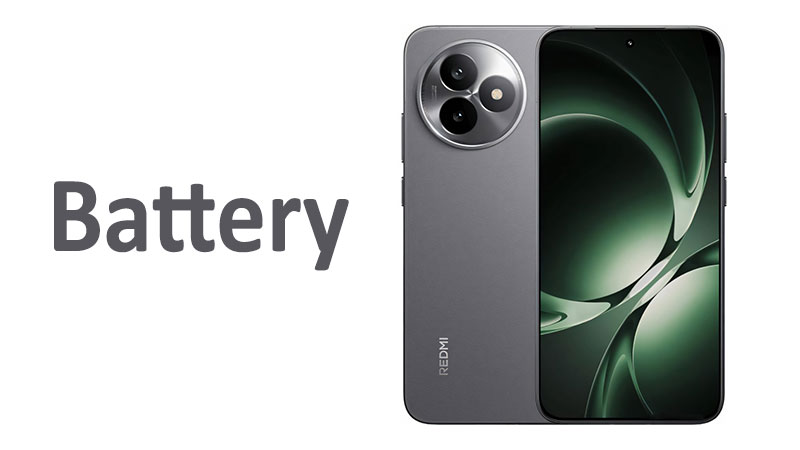The Samsung Galaxy M17 Battery system defines the phone’s identity in the highly competitive mid-range market. Users frequently prioritize extended uptime and dependable power delivery in a modern smartphone. The Galaxy M series, known for its “Mega Battery” focus, must deliver exceptional endurance. This detailed article offers a complete analysis of the M17’s power specifications. We will thoroughly examine the core capacity and the supported charging technology. Understanding these crucial elements is vital for any prospective buyer. This comprehensive guide details the expected stamina, realistic charging times, and essential maintenance tips.
Understanding the Core: 5000 mAh Capacity
The Samsung Galaxy M17 is equipped with a significant 5000 mAh battery capacity. This figure is the established benchmark for all-day endurance in the global smartphone arena. A 5000 mAh cell provides reliably extended usage for virtually every type of consumer. This large capacity directly addresses the common consumer issue of battery anxiety. The substantial size ensures the device can easily sustain a full day of demanding activity. This strong endurance is a key factor driving the popularity of the Galaxy M series.
The M-Series Mega Battery Philosophy
The Galaxy M series is specifically designed around the idea of maximum battery life. While some M-series models have featured 6000 mAh or 7000 mAh cells, the 5000 mAh battery in the M17 offers a balanced approach. It still guarantees excellent longevity without making the phone excessively heavy or thick. Samsung aims to deliver power that lasts all day, every day. This capacity supports the phone’s usage for media consumption and daily tasks effectively. The M17 maintains the reputation of its M-series lineage for long battery life.
The Real-World Impact of 5000 mAh
A 5000 mAh battery translates into compelling real-world performance metrics. For the average user, this capacity typically allows for one and a half to two days of standard usage. Standard usage includes communication, light browsing, and social media scrolling. Moderate users who stream video or use navigation frequently will comfortably achieve a full day of use. The robust capacity minimizes the need for users to consistently seek out a power outlet. This independence from charging cables is a major convenience for travelers and students.
The actual performance of the Samsung Galaxy M17 battery life also depends heavily on software optimization. Samsung’s One UI is engineered to maximize power efficiency. The operating system employs layers to effectively manage background application activity. It prevents idle apps from consuming power unnecessarily. This smart power management ensures the large capacity is utilized wisely. The combination of efficient software and robust hardware creates truly dependable power.
Estimated Screen-On Time Scenarios
We can create realistic estimates for the screen-on time (SOT) across various user profiles.
Light users often find the SOT can exceed 10 hours. This usage pattern involves limited use of power-intensive features like gaming. It effectively demonstrates the phone’s underlying power efficiency.
Moderate users, who utilize video streaming and productivity apps regularly, can expect SOT between 7 and 9 hours. The device manages active multimedia consumption efficiently throughout the day. This makes the M17 an excellent device for long periods away from power sources.
Heavy users, including those who engage in intensive mobile gaming, should anticipate SOT ranging from 5 to 7 hours. Processing high-end graphics demands significant power instantaneously. Despite this strain, the 5000 mAh capacity delivers impressive stamina compared to smaller battery phones. It offers superior endurance for sustained high-performance activities.
The Charging Standard: 25W Wired Fast Charging
Battery capacity is crucial, but modern usability demands rapid power recovery. The Samsung Galaxy M17 supports 25W wired charging. This standard is a strong inclusion for this specific market segment. It strikes a positive balance between charging speed and maintaining the battery’s long-term health. High-speed charging drastically cuts down the time users spend waiting for their phone. This technology effectively manages the large 5000 mAh battery cell.
The 25W Standard Explained
The 25W charging technology delivers a good amount of power quickly and consistently. It represents a clear and necessary upgrade over older, slower standards like 15W. This elevated speed allows the large battery to be replenished far more efficiently. Achieving the maximum 25W rate requires the use of a compatible power adapter. Buyers should note that Samsung commonly sells this specific charger separately from the phone itself. This is a critical detail for buyers to factor into the overall cost.
Although Samsung does not always provide an official 0% to 100% time, we can accurately estimate the duration. A 5000 mAh battery charged at a consistent 25W should take roughly 80 to 90 minutes for a full charge. This timeframe is excellent for a battery of this size and capacity. It means users can quickly top up their battery before heading out for the day. For example, a quick 30-minute charging session can easily add many hours of usable power. The Galaxy M17 charging speed is both competitive and convenient for daily life.
Thermal Management and Safety Protocols
Charging a battery at 25W generates heat, which requires careful management. Effective thermal control is essential for ensuring the integrity of the battery. The Galaxy M17 incorporates safety protocols to continuously monitor temperature levels. These systems actively regulate the heat produced during the 25W fast charging process. Keeping the internal temperature low is important for two main reasons. First, it prevents potential damage to the battery’s internal chemical structure. Second, it allows the phone to sustain the 25W charging rate without throttling down prematurely. If the device detects excessive internal heat, the charging speed automatically reduces. This crucial safety measure protects both the user and the battery’s long-term health.
Pros and Cons of 25W Charging
The major advantage is the significant reduction in overall charging time. The Samsung Galaxy M17 fast charging eliminates the requirement for lengthy overnight charging sessions. It offers excellent convenience for users with unpredictable or busy daily schedules. Another benefit is the proven, stable nature of the 25W standard. This reliability contributes positively to the user experience.
The primary drawback is the common omission of the 25W power adapter. Buyers are frequently required to purchase the specific fast charger separately. This requirement adds an extra, often unexpected, cost to the purchase. Furthermore, some rival budget phones now offer faster charging options, such as 33W or 45W. While the M17’s 25W standard is robust, it is not the fastest on the market. This speed difference may matter to users whose primary concern is the absolute fastest charging speed possible.
Battery Optimization and Longevity Strategies
To fully maximize the long-term utility of the 5000 mAh battery, a combination of intelligent software features and deliberate user habits is required. Samsung integrates numerous tools within One UI designed for power efficiency. Users must also adopt disciplined charging habits to maintain lasting battery health.
Software Optimization in One UI
Samsung’s sophisticated One UI features several advanced utilities for power management. These tools are absolutely central to achieving the maximum daily runtime from the Galaxy M17 battery.
The Adaptive Battery function is a key element of the power management suite. It employs machine learning algorithms to analyze and understand the user’s unique usage patterns. It actively predicts which applications will be used next and optimizes power consumption accordingly. This intelligent system proactively restricts the resources allocated to less-used applications. This efficient process ensures the optimal utilization of the large battery capacity.
One UI also grants users detailed, granular control over individual applications. Users can manually designate apps for “sleep” or “deep sleep” modes. This action prevents the apps from operating in the background and unnecessarily consuming power. A highly customizable Power Saving Mode is also included. This mode can limit the device’s CPU speed, disable the Always On Display, and restrict background network access. This feature is invaluable for extending power when the battery level is critically low.
Daily Tips for Maximizing Battery Life
Simple, small user adjustments can substantially increase the device’s daily runtime. Reducing the screen brightness manually or using automatic adaptive brightness is one of the most effective power-saving actions. The display is consistently the single largest consumer of battery power. Utilizing a dark theme or dark mode also conserves energy effectively on modern displays.
Users should also form the habit of disabling connectivity features when they are not actively required. Turning off Bluetooth, GPS, and Wi-Fi when not in use conserves significant energy. Constantly searching for available networks drains valuable battery resources. Minimizing the use of haptic feedback and vibration alerts also contributes to power conservation. The vibration motor is surprisingly power-hungry compared to standard audio alerts.
Furthermore, regular software maintenance is paramount. Keeping all installed applications and the underlying operating system fully updated ensures peak power efficiency. Developers frequently include critical bug fixes and power-saving improvements in routine software patches. Reviewing the battery usage statistics regularly helps identify and manage the most power-hungry applications.
Long-Term Battery Health Management
Protecting the battery’s long-term health is essential for guaranteeing the phone’s overall lifespan. All lithium-ion batteries naturally degrade over time, but users can significantly slow this process.
The most critical factor is temperature management. Users must strictly avoid charging or using the phone in conditions of extreme heat or extreme cold. High heat, in particular, aggressively accelerates the chemical degradation within the battery cell. While the 25W charging system is thermally managed, the external environment remains important. Users should avoid charging the phone in direct sunlight or leaving it inside a hot car.
Samsung provides a useful “Protect Battery” option within the One UI settings. Activating this setting limits the battery’s maximum charge level to 85%. This practice is strongly endorsed by battery experts globally. Consistently charging the battery past the 80% mark increases chemical stress on the cell. Using this feature can significantly extend the overall functional life of the 5000 mAh battery. Avoiding complete, deep discharges is also generally beneficial for battery health.
Specialized Comparisons and Market Positioning
The Samsung Galaxy M17 battery specifications are carefully positioned within its target market segment. Comparing these specifications against its predecessors and immediate competitors offers crucial context. This comparison helps solidify the M17’s value proposition for potential buyers.
Comparison with Previous Model or Competitors
The Galaxy M series maintains a strong focus on battery evolution. Previous M-series phones, and even some older A-series models, often featured the same 5000 mAh capacity. However, earlier devices sometimes limited charging speeds to 15W. The inclusion of 25W wired charging in the M17 is a clear, necessary step forward in user convenience. This faster speed substantially reduces the overall time required for a full charge. This improvement makes the large battery far more practical for dynamic, everyday use.
Many competitors in the affordable mid-range market also standardly offer 5000 mAh batteries. Brands like Xiaomi, Realme, and others frequently compete heavily on charging speed metrics. Some rivals in this segment now offer faster charging at 33W or even 45W. While the M17’s 25W is not the absolute fastest option, it is a proven, stable, and rapid standard. Samsung often chooses stability and longevity over chasing peak speed numbers. The M17’s system offers a compelling balance of high capacity and respectable charging speed. This combination makes it a highly reliable and durable choice.
The competitive landscape clearly shows that the Galaxy M17 battery focuses on raw endurance and system stability. It does not aim for the fastest charging performance available. Instead, it offers a consistent, guaranteed all-day capacity paired with a modern, capable charging standard. This calculated positioning appeals significantly to users who prioritize brand reliability and sustained long-term power.
Important Points a Buyer or Reader Should Know
First, the 5000 mAh battery cell offers truly excellent, long-lasting power. Buyers can confidently rely on this phone for heavy daily use without constant charging interruptions. Second, the 25W charging capability is adequately fast for the needs of most users. It ensures the phone is quickly ready for use after a short charge.
Third, a potential buyer must explicitly account for the separate cost of the fast charger. The phone typically ships without the necessary 25W adapter. Without purchasing this specific charger, users will be limited to much slower charging speeds. This is a standard Samsung practice but remains a crucial detail for buyers. Fourth, the sophisticated One UI software includes outstanding battery-saving features. Users should proactively utilize tools like Adaptive Battery and the 85% charge limit. This practice helps maximize both immediate daily endurance and long-term battery health.
The overall physical design ensures the inclusion of the large battery does not result in an overly bulky or heavy phone. Samsung successfully maintains a manageable form factor despite the high capacity. This strategic balance of power, size, and portability is a core strength of the Galaxy M17.
Buyer’s Guide: Pros, Cons, and Key Takeaways
The Samsung Galaxy M17 battery system provides a reliable and highly pragmatic power solution. Carefully evaluating its advantages and disadvantages helps potential buyers arrive at an informed purchasing decision.
Pros
The 5000 mAh capacity delivers outstanding and highly dependable daily endurance. The 25W fast charging provides a substantial speed improvement over older charging standards. It ensures the large battery can be quickly and efficiently refueled. Samsung’s One UI offers sophisticated, granular software optimization tools. These tools allow users to precisely fine-tune their power usage for maximum efficiency. The charging standard is proven, stable, and positively contributes to excellent long-term battery health.
Cons
The maximum 25W speed is noticeably slower compared to the higher-wattage offerings from some direct budget competitors. These rival brands may offer 33W or 45W speeds. The required 25W charger often necessitates a separate purchase. This adds an extra, initial cost to the overall device ownership. The phone does not feature support for wireless charging functionality. Wireless charging is a feature typically reserved for Samsung’s more premium flagship devices.
Key Takeaways
The battery system within the Samsung Galaxy M17 is engineered for stability, consistency, and maximum endurance.
First, the 5000 mAh capacity assures users of confidently achieving reliable all-day power. Second, the 25W technology provides a good, rapid level of charging convenience. Third, the included software tools, managed through One UI, are industry-leading for comprehensive battery management. They offer excellent control and efficiency for daily use.
The Galaxy M17 is an excellent choice for any user who absolutely prioritizes reliable, sustained stamina. It is highly suitable for demanding everyday use, continuous multimedia streaming, and general productivity tasks. The robust battery solution ensures the device functions as a trustworthy, enduring workhorse in the mid-range category.
Conclusion
The Samsung Galaxy M17 Battery system successfully meets the M-series mandate for enduring power. The combination of the sizeable 5000 mAh capacity and the capable 25W wired charging is highly effective. The large cell virtually eliminates daily power anxiety for the vast majority of users. Furthermore, the 25W charging speed ensures that the phone’s downtime is effectively minimized. While the charger requires a separate purchase, the resulting speed and convenience are fully justified. Samsung’s established emphasis on software optimization through One UI significantly enhances both efficiency and longevity. The Galaxy M17 provides a reliable, well-engineered, and extremely powerful solution. This makes it an informed and strong choice for the budget-conscious consumer seeking sustained, multi-day performance.
Frequently Asked Questions (FAQ)
What is the typical battery life I can expect from the Galaxy M17?
Most users can easily expect the Samsung Galaxy M17 to last for a full day of heavy use. Moderate users may achieve up to two days of usage time.
Does the Samsung Galaxy M17 include the 25W charger in its retail box?
The Samsung Galaxy M17 often does not include the 25W power adapter. Users must typically purchase this specific fast charger separately.
How long does it take to fully charge the 5000 mAh battery at 25W?
Using the official 25W fast charger, the 5000 mAh battery usually requires about 80 to 90 minutes to charge completely from a zero percent level.
Can I limit the charge level to protect the long-term battery health of the M17?
Yes, Samsung’s One UI includes a “Protect Battery” feature. This setting limits the maximum charge level to 85% to help significantly prolong the battery’s lifespan.
What is the main battery difference between the M17 and the M-series flagships?
While the M17 has 5000 mAh, some M-series models prioritize even larger capacity, offering up to 6000 mAh or 7000 mAh batteries for maximum, multi-day endurance.



